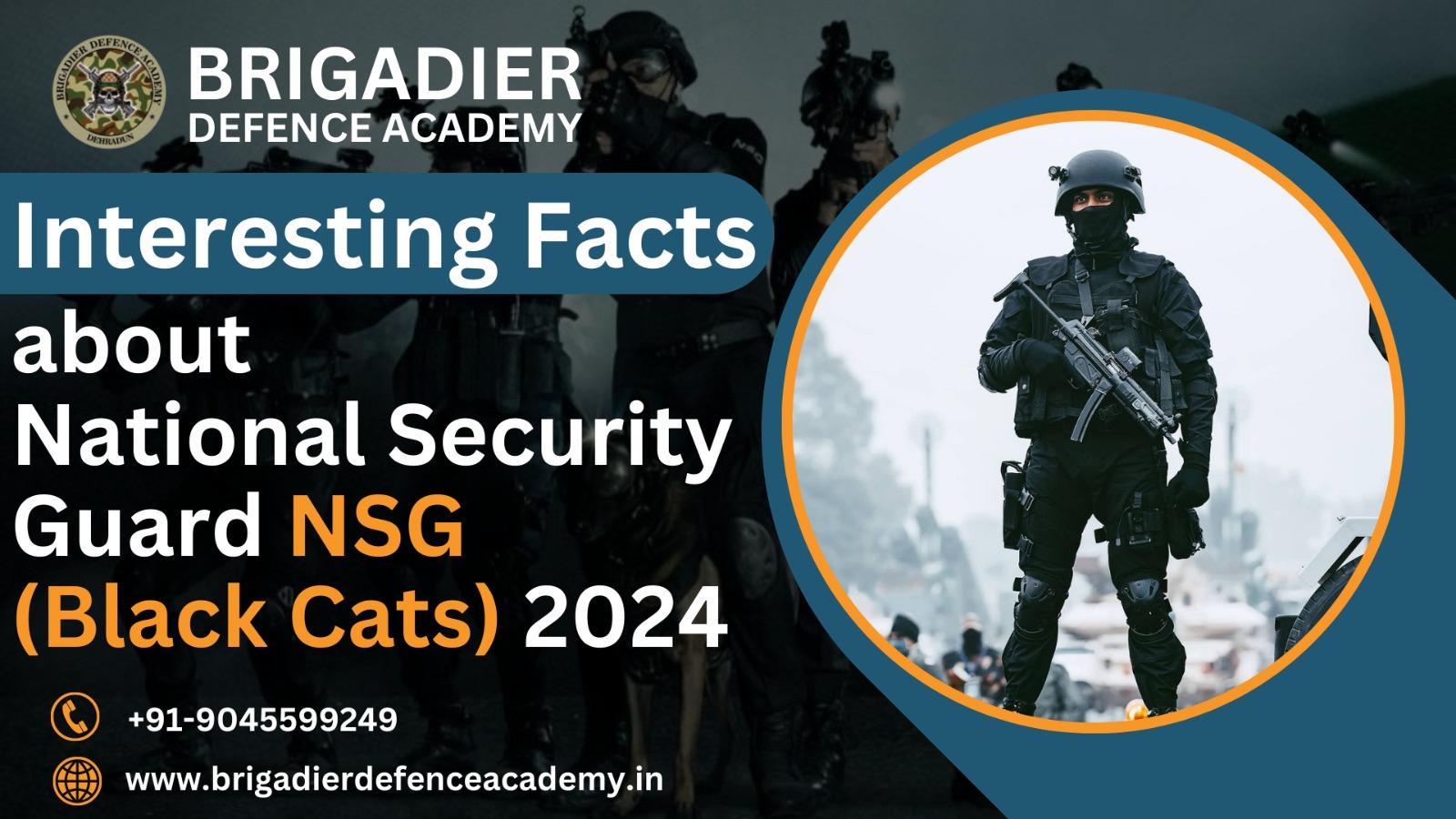- Posted on
- Manya
- No Comments
Introduction to the National Security Guard (NSG)
The National Security Guard (NSG), commonly known as the “Black Cats,” is an elite counter-terrorism unit in India. Formed in 1984, the NSG has gained a reputation for its specialized training, quick response capabilities, and high level of operational readiness. This elite force is tasked with handling critical situations such as terrorist attacks, hijackings, and hostage rescue operations. In this comprehensive article, we will delve into the history, organization, training, operations, and significance of the National Security Guard.
The National Security Guard is a specialized counter-terrorism unit under the Ministry of Home Affairs, Government of India. It was established in 1984 following the recommendations of the Task Force on National Security and was formally inaugurated on October 16, 1986. The primary objective of forming the NSG was to combat terrorism and provide a swift and effective response to terrorist threats across the country.
The NSG is commonly referred to as the “Black Cats” due to the black uniforms worn by its commandos during operations. The force comprises highly trained personnel from the Indian Army and Central Armed Police Forces (CAPF). NSG commandos are known for their professionalism, courage, and tactical expertise in dealing with high-risk situations.
History of the National Security Guard
The origins of the NSG can be traced back to the 1980s when India faced several high-profile terrorist incidents, including the hijacking of Indian Airlines Flight 423 in 1984. The need for a specialized force capable of handling such crises became evident, leading to the formation of the NSG.
Formation and Early Years
The decision to create the National Security Guard National Security Guard (NSG) was prompted by the recommendations of the Task Force on National Security chaired by the then Deputy Prime Minister, R. Venkataraman. The force was officially established on September 22, 1986, with its headquarters in New Delhi.
The initial years were focused on recruiting and training personnel to meet the rigorous standards set for National Security Guard (NSG) commandos. Training programs were designed to enhance skills in counter-terrorism operations, hostage rescue, close-quarter battle (CQB), explosive ordnance disposal (EOD), and marksmanship.
Major Operations and Contributions
Since its inception, the NSG has been involved in several high-profile operations that showcased its capabilities and effectiveness in dealing with complex security challenges. Some notable operations include:
- Operation Black Thunder (1988): The NSG was deployed to flush out militants holed up inside the Golden Temple in Amritsar during Operation Black Thunder.
- Operation Ashwamedh (2002): NSG commandos were mobilized during Operation Ashwamedh to secure vital installations in the aftermath of the terrorist attack on the Indian Parliament in December 2001.
- Mumbai Terror Attacks (2008): The NSG played a crucial role in responding to the coordinated terrorist attacks in Mumbai in November 2008. The force engaged terrorists at various locations, including the Taj Mahal Palace Hotel and Nariman House, demonstrating their tactical prowess and bravery.
- Pathankot Airbase Attack (2016): NSG teams were deployed to neutralize terrorists who attacked the Pathankot Air Force Station in Punjab, highlighting their rapid response capabilities and coordination with other security agencies.
These operations underscore the NSG’s role as a premier counter-terrorism force capable of handling diverse challenges with precision and decisiveness.
Organization and Structure of the NSG
The National Security Guard is structured into several components, each playing a vital role in fulfilling the organization’s mission. Let’s explore the key components of the NSG:
1. Special Action Group (SAG)
The Special Action Group is the primary operational wing of the National Security Guard (NSG) responsible for conducting counter-terrorism and hostage rescue missions. SAG commandos undergo extensive training in advanced combat tactics, urban warfare, sniping, explosives handling, and specialized weaponry.
2. Special Rangers Group (SRG)
The Special Rangers Group provides support to the SAG during operations. SRG personnel are trained in perimeter security, cordoning off areas, crowd control, and providing backup to SAG commandos as needed.
3. Training Wing
The NSG’s Training Wing is responsible for conducting specialized courses and training programs for NSG personnel as well as imparting training to state police forces and other security agencies. Training includes marksmanship, tactical drills, crisis management, and medical first response.
4. Headquarters Support Group (HSG)
The Headquarters Support Group handles administrative, logistical, and technical support functions for the NSG. This includes procurement of equipment, maintenance of facilities, communication systems, and coordination with government agencies.
5. National Bomb Data Centre (NBDC)
The NBDC is an integral part of the National Security Guard (NSG) focused on gathering and analyzing information related to explosive devices, bomb threats, and emerging trends in bomb-making techniques. This intelligence helps in planning and executing counter-terrorism operations more effectively.
Training and Selection Process
The selection and training process for NSG commandos is among the most rigorous in the world. Candidates undergo a series of assessments to test their physical fitness, mental aptitude, and tactical skills. The training regimen includes:
- Physical Fitness Tests: Candidates undergo rigorous physical tests including running, obstacle courses, endurance drills, and swimming tests to assess their fitness levels.
- Marksmanship Training: NSG commandos receive extensive training in various firearms, including pistols, rifles, submachine guns, and sniper rifles. They undergo marksmanship drills to enhance accuracy and proficiency in shooting under different scenarios.
- Close-Quarter Battle (CQB) Techniques: Training in CQB involves mastering tactics for room clearing, hostage rescue, and engaging targets in confined spaces. Commandos learn to work in teams and coordinate movements seamlessly during high-stress situations.
- Explosive Ordnance Disposal (EOD): NSG personnel are trained in identifying and safely neutralizing explosive devices. This includes bomb detection, disposal techniques, and understanding explosive materials and their effects.
- Combat Medic Training: Commandos receive basic medical training to provide immediate first aid and medical assistance during operations. This includes treating injuries, managing trauma, and evacuation procedures.
- Specialized Courses: NSG commandos may undergo specialized courses such as combat diving, parachuting, tactical driving, and advanced weaponry training based on their roles and responsibilities within the force.
The training curriculum is dynamic and constantly updated to address evolving threats and security challenges. National Security Guard (NSG) instructors are seasoned veterans with extensive operational experience, ensuring that commandos are equipped with the skills and mindset required for high-intensity operations.
Operational Capabilities and Equipment
The NSG is equipped with state-of-the-art weapons, gear, and technology to enhance its operational capabilities. Some of the key equipment and assets used by NSG commandos include:
- Firearms: Personnel are equipped with a range of firearms including Glock pistols, MP5 submachine guns, AK-47 assault rifles, INSAS rifles, sniper rifles such as Dragunov and SIG Sauer, and grenade launchers.
- Body Armor and Tactical Gear: Commandos wear ballistic helmets, bulletproof vests, tactical goggles, knee/elbow pads, and specialized clothing designed for combat situations. They also use communication equipment for team coordination and situational awareness.
- Explosive Detection and Disposal Equipment: The National Security Guard (NSG) utilizes advanced equipment for bomb detection such as portable X-ray machines, bomb suits.







